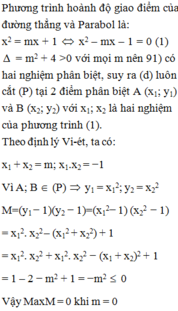Hãy nhập câu hỏi của bạn vào đây, nếu là tài khoản VIP, bạn sẽ được ưu tiên trả lời.

Pt hoành độ giao điểm: \(x^2-mx-1=0\)
\(ac=-1< 0\Rightarrow\) (d) luôn cắt (P) tại 2 điểm pb
Theo hệ thức Viet: \(\left\{{}\begin{matrix}x_1+x_2=m\\x_1x_2=-1\end{matrix}\right.\)
\(y_1+y_2=y_1y_2\Leftrightarrow mx_1+1+mx_2+1=x_1^2x_2^2\)
\(\Leftrightarrow m\left(x_1+x_2\right)+2=1\)
\(\Leftrightarrow m^2+1=0\) (vô nghiệm)
Vậy ko tồn tại m thỏa mãn đều bài
\(x_M=\dfrac{x_A+x_B}{2}=\dfrac{m}{2}\) ;
\(y_M=\dfrac{y_A+y_B}{2}=\dfrac{mx_A+1+mx_B+1}{2}=\dfrac{m\left(x_A+x_B\right)+2}{2}=\dfrac{m^2+2}{2}\)
\(\Rightarrow\left\{{}\begin{matrix}m=2x_M\\m^2=2y_M-2\end{matrix}\right.\)
\(\Rightarrow\left(2x_M\right)^2=2y_M-2\)
\(\Rightarrow y_M=2x_M^2+1\)
\(\Rightarrow\) Quỹ tích M là parabol có pt \(y=2x^2+1\)

\(\left\{{}\begin{matrix}\left(P\right):y=x^2\\\left(d\right):y=-x+2\end{matrix}\right.\)
a) Tọa độ giao điểm của (P) và (Q) là nghiệm của hệ phương trình
\(\left\{{}\begin{matrix}y=x^2\\y=-x+2\end{matrix}\right.\) \(\Leftrightarrow\left\{{}\begin{matrix}y=x^2\\x^2=-x+2\end{matrix}\right.\) \(\Leftrightarrow\left\{{}\begin{matrix}y=x^2\\x^2+x-2=0\left(1\right)\end{matrix}\right.\)
\(pt\left(1\right)\Leftrightarrow\left[{}\begin{matrix}x=1\\x=-2\end{matrix}\right.\) \(\left(a+b+c=1+1-2=0\right)\)
\(hpt\Leftrightarrow\left[{}\begin{matrix}\left\{{}\begin{matrix}x=1\\y=1\end{matrix}\right.\\\left\{{}\begin{matrix}x=-2\\y=4\end{matrix}\right.\end{matrix}\right.\)
Vậy tọa độ giao điểm của (P) và (Q) là \(A\left(1;1\right)\&B\left(-2;4\right)\)
a) Phương trình hoành độ giao điểm :
x2 = - x + 2
<=> (x - 1)(x + 2) = 0
<=> \(\left[{}\begin{matrix}x=1\\x=-2\end{matrix}\right.\)
Với x = 1 ta được y = 1
Với x = -2 ta được y = 4
Vậy tọa độ giao điểm là A(1; 1) ; B(-2;4)
b) Gọi C(-2 ; 0) ; D(1;0)
ta được \(S_{AOB}=S_{ABCD}-S_{BOC}-S_{AOD}\)
\(=\dfrac{\left(BC+AD\right).CD}{2}-\dfrac{BC.CO}{2}-\dfrac{AD.DO}{2}\)
\(=\dfrac{\left(4+1\right).3}{2}+\dfrac{4.2}{2}+\dfrac{1.1}{2}=12\) (đvdt)

Tọa độ điểm A là:
\(\left\{{}\begin{matrix}y=0\\\left(m-1\right)x-2=0\end{matrix}\right.\)
=>\(\left\{{}\begin{matrix}y=0\\x\left(m-1\right)=2\end{matrix}\right.\Leftrightarrow\left\{{}\begin{matrix}y=0\\x=\dfrac{2}{m-1}\end{matrix}\right.\)
=>\(A\left(\dfrac{2}{m-1};0\right)\)
Tọa độ B là:
\(\left\{{}\begin{matrix}x=0\\y=\left(m-1\right)\cdot x-2=0\left(m-1\right)-2=-2\end{matrix}\right.\)
=>B(0;-2)
O(0;0); \(A\left(\dfrac{2}{m-1};0\right)\); B(0;-2)
\(OA=\sqrt{\left(\dfrac{2}{m-1}-0\right)^2+\left(0-0\right)^2}=\sqrt{\left(\dfrac{2}{m-1}\right)^2}=\dfrac{2}{\left|m-1\right|}\)
\(OB=\sqrt{\left(0-0\right)^2+\left(-2-0\right)^2}=\sqrt{0+4}=2\)
Vì Ox\(\perp\)Oy
nên OA\(\perp\)OB
=>ΔOAB vuông tại O
=>\(S_{OAB}=\dfrac{1}{2}\cdot OA\cdot OB=\dfrac{1}{2}\cdot2\cdot\dfrac{2}{\left|m-1\right|}=\dfrac{2}{\left|m-1\right|}\)
Để \(S_{OAB}=8\) thì \(\dfrac{2}{\left|m-1\right|}=8\)
=>\(\left|m-1\right|=\dfrac{1}{4}\)
=>\(\left[{}\begin{matrix}m-1=\dfrac{1}{4}\\m-1=-\dfrac{1}{4}\end{matrix}\right.\Leftrightarrow\left[{}\begin{matrix}m=\dfrac{5}{4}\\m=\dfrac{3}{4}\end{matrix}\right.\)

A, B thuộc (P), (d) ?
Phương trình hoành độ giao điểm của (P) và (d) là:
\(x^2=k\left(x-1\right)+2\Leftrightarrow x^2-kx+\left(k-2\right)=0\).
Ta có \(\Delta=k^2-4\left(k-2\right)=\left(k-2\right)^2+2>0\forall k\) nên phương trình trên luôn có hai nghiệm phân biệt.
Theo hệ thức Viète ta có \(\left\{{}\begin{matrix}x_1x_2=k-2\\x_1+x_2=k\end{matrix}\right.\).
Ta có \(x_1^2+y_1+x_2^2+y_2=14\)
\(\Leftrightarrow2x_1^2+2x_2^2=14\)
\(\Leftrightarrow\left(x_1+x_2\right)^2-2x_1x_2=7\)
\(\Leftrightarrow k^2-2\left(k-2\right)=7\Leftrightarrow k^2-2k-3=0\)
\(\Leftrightarrow\left[{}\begin{matrix}k=-1\\k=3\end{matrix}\right.\).
Vậy...

a: 
b: PTHĐGĐ là:
x^2+x-2=0
=>(x+2)(x-1)=0
=>x=-2 hoặc x=1
=>y=4 hoặc y=1
